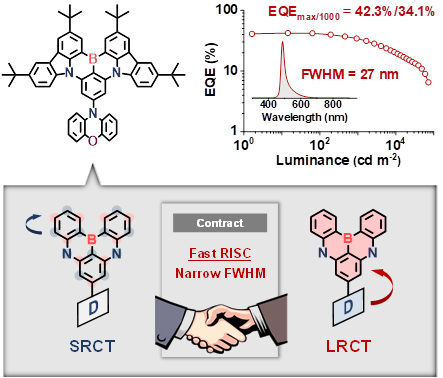The development of organic electroluminescent materials and devices with narrow-band emission has emerged as a critical requirement to meet the demands of high-definition displays while maintaining the competitive edge of organic light-emitting diode (OLED) technology. Among the research endeavors in the field of organic electroluminescence, materials based on multiple resonance thermally activated delayed fluorescence (MR-TADF) have attracted substantial attention due to their advantages of narrow-band emission and high efficiency, owing to their rigid frameworks and unique short-range charge transfer (SRCT) properties. However, these materials suffer from a characteristic drawback, namely a sluggish reverse intersystem crossing rate (kRISC), which results in substantial efficiency roll-off at high luminance levels in corresponding OLED devices, thereby hindering their practical applicability.
To address the aforementioned challenges, Professor Chuluo Yang's team at Shenzhen University has spearheaded a novel approach by incorporating sulfur and selenium elements into rigid multiple resonance frameworks. This strategic integration leverages the heavy atom effect to augment the spin-orbit coupling (SOC) between singlet/triplet excited state orbitals, resulting in a pronounced enhancement of the kRISC process. Consequently, electroluminescent materials and devices exhibiting both high luminous efficiency and reduced efficiency roll-off have been realized (Nat. Photonics 2022, 16, 803). However, it should be acknowledged that the larger atomic radius of heavy atoms inevitably introduces significant structural relaxation in both the ground and excited states, thereby compromising the color purity of the materials. In light of this concern, the research team has formulated a molecular design strategy for charge transfer excited state modulation, inspired by the traditional donor-acceptor (D-A) type TADF materials. The crux of this approach entails orthogonal connection of suitable electron donor units with boron atoms in a boron-nitrogen fused-ring framework. By adhering to the prerequisite of preserving the SRCT characteristics of the lowest singlet excited state (S1), this strategy facilitates the deliberate introduction of long-range charge transfer triplets (3LRCT), which expedite the reverse intersystem crossing process. Consequently, the resulting electroluminescent materials manifest simultaneously narrow full-width at half-maximum, high efficiency, and rapid kRISC. The corresponding OLED device exhibits an exceptional spectral full-width at half-maximum of merely 27 nm, accompanied by an impressive external quantum efficiency of up to 42.3% and minimal efficiency roll-off (34.1% at 1000 cd/m²).

The findings of this research work provide a versatile molecular design strategy for the development of commercially viable high-performance MR-TADF materials. The associated research article, titled "Charge Transfer Excited State Promoted Multiple Resonance Delayed Fluorescence Emitter for High-Performance Narrowband Electroluminescence," was published online on June 5, 2023, in Journal of the American Chemical Society (JACS). The paper is authored by Assistant Professor Zhongyan Huang from Shenzhen University, with Assistant Professor Xiaosong Cao and Professor Chuluo Yang serving as the corresponding authors. This work was made possible by generous support from the National Natural Science Foundation of China, the Guangdong Provincial Basic and Applied Basic Research Foundation, and the Shenzhen Municipal Science and Technology Innovation Commission.
For the full article, please refer to the following link: https://pubs-acs-org-s.webvpn.szu.edu.cn/doi/full/10.1021/jacs.3c01267